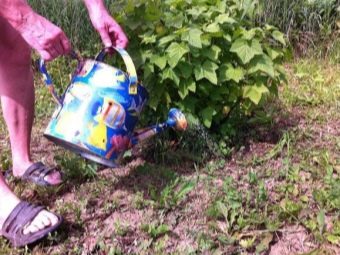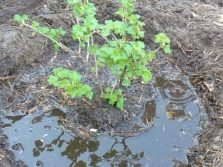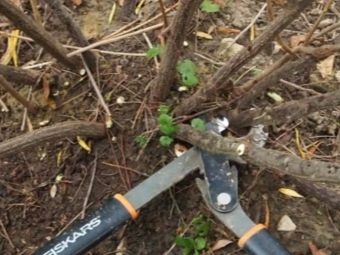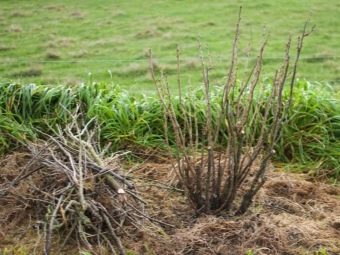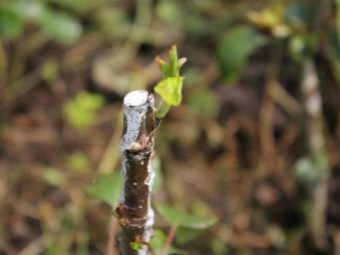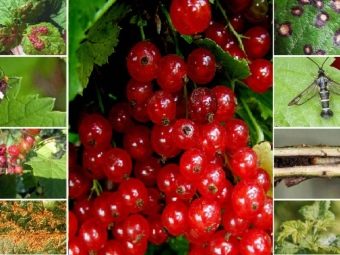Features of growing red currant
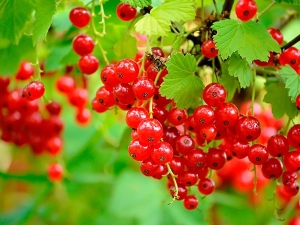
Red currant is a nutritious berry that grows in many areas.The shrub has a high yield and early maturity. Each summer resident must study the peculiarities of cultivation of this crop in order to get a rich harvest every year.
Culture description
Red currant belongs to the category of deciduous shrubs of small size, which are located in the gooseberry family. Berry grows best on the territory of European and Asian countries, as well as in Siberia. For this reason, the regions of central Russia are considered the best option for growing red currants. The wild berry ripens on the forest edges, river banks.
The first to plant red currants began the Dutch in the V century. However, in those days this shrub was used as an ornamental, so currants were often used as an element of the landscape. Later, people were able to appreciate the taste and healthy qualities of a valuable berry and began to grow it for harvesting.
In Russia, shrubs appeared in the 15th century and quickly won love among gardeners.
Features of red currant are as follows.
- This is an early crop with good yields. It belongs to the category of perennial plants.
- If we compare the red currant with the black currant, the bushes of the first bush have a more compact size. The shape is slightly elongated and compressed at the sides.
- The shrub has developed roots that grow deep in the ground. Due to this feature, the plant receives nutritional components and actively develops every year.
- Young shoots are characterized by yellow color, which during growing becomes green. The height of adult currant is 100-200 cm.
- In the spring season on the shrub grows a lot of leaves, which are medium in size and may vary in shape. The presence of solid, three-bladed and five-lobed leaves, which are arranged in turn.
- The outer part of the leaf is dark green, has a smooth and shiny surface. At the bottom there is a lighter color, and the surface of the leaf plate is dull, with a small degree of pubescence.
- On the bush there are many buds, so each shrub brings a large amount of harvest.
- In the spring, the buds turn into simple flowers that may have a green or reddish brown color. Buds are collected in racemes.
- Berries begin to appear later, compared with the fruits of black currant. Due to this feature, the shrub is almost not affected by frost.
- Fruits differ juiciness and sourish taste. The size can reach 1 cm in diameter. On the bushes are formed beautiful tassels hanging type. The color of the berries can be different: from dark red to pink.
- The lifespan of a red currant bush reaches 35 years.
- Fruits have numerous beneficial qualities. They can remove harmful substances from the human body and contain many vitamins in their composition.
What can you plant next?
There is an opinion that other types of plants should not be planted near the red currant. However, the majority of gardeners want to completely spend free space on their site, therefore, looking for options for combining vegetation. Since redcurrant is a plant with a high degree of chemical activity, it is not allowed to place varieties with similar composition or components next to it.
It is best to locate honeysuckle bushes, yoshta, apple trees, as well as strawberries, onions, garlic and other varieties of spicy vegetation near the red currant.
Solanaceae
Near the currant is allowed to plant various types of solanaceous crops. Tomato, pepper and other plants will benefit from such a neighbor. Present in the composition of currants phytoncides will help deter pests.
Honeysuckle
These shrubs have similarity with currants.They also contain vitamins from group C, they are distinguished by a high degree of resistance to frost and do not require special care. Chemical compatibility with currants is characteristic of honeysuckle.
Yoshta
Yoshta can develop normally near the gooseberry or currant bushes, as it belongs to the category of their hybrids. This is a hardy shrub, which is not afraid of any neighbors. It is often planted near the currant, as it is not afraid of their typical disease - a kidney tick, which contributes to the development of terry.
Apple tree
Apple tree is considered the best option for the neighborhood next to the currant. Both cultures will not adversely affect the yields and will be able to fully develop.
Landing next to other species
Many gardeners plant strawberries or strawberries between the rows of currants. In this neighborhood, there is one major drawback, which is the inconvenient assembly of the fruit. Currant does not have a negative impact on strawberries and protects it from all sorts of pests. Onions and garlic can act as a defense against the kidney mite, which is a common disease among currants.
Next to what plants is undesirable to plant red currants?
There are several key factors on the basis of which several undesirable neighborhoods have been identified for red currants. It is undesirable to plant shrubs near plants that are susceptible to similar parasites or diseases. For currants, this plant is gooseberry. Both types of shrubs suffer from gooseberries, so this neighborhood is inappropriate. Black currant is an undesirable neighbor for red (white currant will also feel uncomfortable). If you plant these crops side by side, a decrease in yield indices will be observed on the plot.
Landing
Planted in open ground red currants can be in spring or autumn. However, in shrubs the growing season begins very early, so the autumn period is considered the best option. You can plant currant seedlings on high ground and in areas where there is high-quality lighting. A shrub like sandy or loamy type of soil. The plant does not impose requirements with respect to the content of mineral substances in the soil, but with a lack of components, currants will begin to drop ovaries with fruits.
If planting is done in the fall, experienced gardeners recommend starting it in September.
Step-by-step instructions for planting currants is as follows.
- The first step is to prepare the landing holes. 21 days before disembarking, you will need to create a pit, the depth of which is 40 cm, width 60 cm.
- Humus (two buckets) is poured at the bottom of the hole along with complex mineral fertilizers. After that, you can add fertile soil and irrigate. This procedure makes the earth more dense.
- After three weeks you can start planting. The roots of the bush should be cut a little, and the plant itself deepens by 8 cm. It should be buried slightly above the root collar. This method of planting has a positive effect on the development of the root kidney.
- Planting shrubs should be made in the top layer of soil. If you plant it in the fertilized level, the bush will begin to actively grow, and the process of fruiting will be postponed.
- Planted bushes are watered, and shoots are pruned. The shortening of the stems is at a height of 25 cm from ground level.
- Then the ground is mulched with straw, peat or fallen leaves.
- When the soil starts to freeze, you should add a little humus. Such an additive will act as root protection against accumulated moisture.
Care
For red currants should be properly care. Only with proper care, the shrub will be able to please its owner with good yield and development.Care is watering, feeding, pruning and garter bushes with lots of fruit. Around the bush should be systematically loosen the soil and remove weeds. Peripheral pristvolnogo bush must dig. Care must be taken to prevent damage to the root system.
Watering
Red currant loves moderate watering. Frequent watering will be required in hot time. Also, the plant will need to be watered often after flowering, when the fruits begin to ripen. So that the soil in the near-stem circle has been wet for a long time, mulching will be required. This simple method reduces the time spent on care, as the mulched soil does not need weeding and loosening.
Top dressing
Growing currant bushes includes feeding. During its development, the plant spends nutrients that are located in the ground. In order to observe high-quality fruiting every year, you should systematically replenish food stocks. To do this, you need to add to the soil fertilizing mineral and organic character.
In the spring, it is best to use a mixture that consists of the following components:
- compost (5 kg);
- superphosphate (20 g);
- potassium sulfate (25 g).
These figures are calculated per square meter. You can also feed the soil with urea (15 g) or ammonium nitrate (25 g per square meter). After the currant blooms, you should add a liquid mullein or chicken droppings under the bush. After the harvest is complete, in the autumn season it is recommended to use 100 g of superphosphate, 30 g of potassium chloride for each bush. After that, you can begin to mulch the soil with rotted manure. Some gardeners use foliar top dressing.
During flowering, you can use the following solution:
- 0.5 small spoon of boric acid;
- 10 liters of warm water.
Formed mixture should be sprayed shrub. And if the currant is located on a light sandy soil, in June you will need to feed with the help of slurry. Proportions are: 1 liter of fertilizer per bucket of water. Alternatively, you can use bird droppings.
Pruning
Before pruning, determine the purpose for which this process is planned. There is a rejuvenating pruning, shaping and sanitary measures.
Rejuvenating
If you want to rejuvenate the bush, resorted to the removal of the most unproductive branches. You should also cut the shoots on the ring.
Features of anti-aging pruning are as follows.
- You need to remove the darkened and too thick branches. You will need to check for the presence of branches affected by lichen (they are also deleted).
- Cutting should be carried out under the root. Hemp should not remain.
- The cut must be treated with a garden decoction. It is a mixture containing wax, vegetable fat and rosin.
- If in the depths of the bush is located a lot of zero shoots, you need to remove some of the branches and leave only the strongest.
- After the pruning process will require feeding, abundant watering and mulching pristvolnogo circle.
Shrub formation
During the formation of the bush given a certain form, which must be constantly maintained. Based on the frequency of planting, you should leave more or fewer branches. If planting is too frequent, pruning should be more intense. During this event should be left on the bush branches of different ages. Due to this currant will constantly bear fruit and recover quickly. Most often during pruning resorted to shtambovym formation.
This form is created as follows.
- After disembarking, it is necessary to leave only the main shoot and shorten it by half.
- The following year, in the autumn period (if two-year bushes were purchased), the kidneys should be removed along the entire height of the trunk, leaving only 4 shoots that look in different directions. Similarly, the skeleton of a shrub is defined.
- In the third year of development, you need to cut out all the root growths and growths located on the trunk. Strong shoots are shortened by half, on the outer bud. The length of the conductors remains unchanged.
- In the spring should remove all weak and broken branches. In summer, unproductive branches should be shortened.
Sanitary pruning
This event begins in the spring. During it, frost-struck, broken and growing inward crown branches are removed. Sanitary pruning is done throughout the growing season. If parasitic kidneys are found, they are also removed.
Conditions for sanitary pruning are as follows.
- The center of the shrub should be released so that all branches can be evenly illuminated.
- In autumn, the lateral branches must be removed by half on the outer bud. Using this method, branching is activated.
- After pruning, 4 shoots of different ages should be left. Due to this method, the bush will actively bear fruit and develop.
- The cut should be located no further than 5 mm from the kidney. Secateurs should be placed at an angle of 45 degrees relative to the branch.
- Pruning of tops that are 2–3 years old is not allowed. This is due to the fact that with their help the currant bush is actively bearing fruits.
- If a branching is observed and one of the shoots is directed downwards or in a horizontal plane, it will be necessary to remove such a branch.
- All horizontal shoots need to be removed so that the berries are located on the upper levels. Such fruits will receive more sunlight and ripen faster.
- You can not allow thickening of the bushes. Every year should leave a couple of strong zero shoots, and cut off the rest.
- From the fourth year of development of the bush, you can begin to slice under the root of the old branches.
- In the spring, radical shoots are removed. In the fall, you need to shorten the shoots of the second plan by 10 cm on the bud, which grows out.
- Branches without fruits are removed under the root of the ring. Hemp can not leave. If thickening shoots are removed, all cuts should be made at ground level.
Breeding
The red currant is most easily propagated by cuttings or cuttings. When choosing this method, a young bush will be able to completely repeat the original shrub.
Reproduction using cuttings
In late August, during the anti-aging pruning, you will need to cut a couple of shoots and cut them into several pieces (20-25 cm). All foliage is removed. Each shoot must have several buds (4-5 pieces), the lower cut must be oblique. It should be placed 1 cm below the kidney. The upper cut must be placed at the same distance. All cuttings are dipped in the tool "Kornevin" and landed in the ground for permanent residence. Alternatively, it can be planted under rooting. It is produced in a separate bed, where there is loose earth.
The planting of the future shrub should be made at an angle of 45 degrees. Two buds are immersed in the soil, and the rest should be located above the ground. When planting, observe the distance between plants of 15-20 cm. Then, the cuttings must be watered, the soil is mulched using loose compost, dry soil or peat. Do not allow the soil to dry out. In the last decade of autumn, the cuttings have time to take root, and the next year they form shoots.
Propagation by cuttings
This breeding method is best done in the spring. To do this, choose last year's escape and bends down to the ground, where a groove has been created in advance (the depth of the pit should be 5-8 cm). The escape should be laid in such a way that its upper part is located on the surface, and the body itself in a recess.Pinning is carried out using a wire arc, after which the shoot is sprinkled with loose soil 1 cm.
When sprouts from buds grow by 10 cm, they should be sprinkled with loose soil to the upper foliage. The soil should always be wet. It is necessary to pour the soil several times during the summer season. In September, you can cut off the escape from the original bush and carefully dig it. The branch is cut into several parts (depending on the number of rooted shoots), and the educated segments are planted in a permanent place of residence.
Graft
Many gardeners resort to vaccination. Red currant can take root on different plants: on black currant, cherry, gooseberry, mountain ash. As a rule, vaccination is carried out in early spring or summer. The timing depends on what material is used for the stock. In the spring, it is best to use lignified shoots that are prepared in advance in autumn or winter. Inoculation can solve many problems, but most often this process is used to create a currant tree. Inoculation is as follows.
- On the stock you need to choose the strongest escape, which is located vertically. The remaining processes are cut at the root.
- Then you should pick up a stem of identical size for the graft.
- At the bottom of the graft you need to make an oblique cut. The length of the cut should be three diameters of the cutting. After this, the shoot is placed in a glass with “Heteroauxin”.
- On the stock, make an identical cut at the required height. As a rule, this parameter is 60 cm. The cut place is also wetted with “Heteroauxin”.
- Then you need to get the cutting out of the solution and make on the lower section a tongue, the length of which is a couple of mm.
- A cutting is applied to the stock and a cut is outlined, which should coincide in its location with the tongue. Then an identical tongue is created on the stock.
- Now you can dock the graft with the stock, like a puzzle.
- Then the vaccination site is tied with a coping tape or similar material.
- The upper part of the escape with strapping must be covered with garden broth. The kidneys, which are located on the trunk, should be blinded. After that, the plant is tied to a support.
- This method can be used not only during the formation of shtambov. This method is considered the best option for spring grafting.
Diseases and pests
Red currant is often attacked by various insects. Also, this plant may be subject to various diseases. To cure the plant and eliminate its death, you should familiarize yourself with the main diseases of the shrub.
Many gardeners face the following problems.
- Aphid attack. The plant begins to lag behind, foliage fades and frowns. Red bumps appear on the surface of the sheet plate. Usually, aphids are collected on the inside of the leaf.
- Ognevka. This parasite leaves behind a thin web that affects the plant completely. You can also see small caterpillars that eat the green mass of shrubs.
- Yellow sawfly. This pest is engaged in laying of larvae, which gradually eats the whole plant.
- Spider mites. Characteristic features: faded foliage, sticky web on the stem.
- Kidney mites. They are the distributor of a dangerous disease - woods. The disease is incurable, so the currant bush dies completely. Recognize the disease can be a modified form of the sheet, lack of color and ovary.
- The moth. This is a caterpillar that eats red currant leaves completely.
- Zlatka. She eats the juicy part of the shoots.
To combat these pests can be with the help of special tools. Good results were shown: Fury, Fufanon, Karbofos, Aktara, Bankol, Confidor, Biotlin. Some summer residents resort to folk methods.Spraying with the help of soap or garlic solution, as well as powder with ashes are actively used. All affected areas should be removed and burned.
Anthracnose
This is a fungus that appears due to wet and humid climatic conditions. The disease can be identified by small brown spots, which soon begin to grow and absorb most of the foliage. For the treatment of anthracnose use fungicides. For prevention, you can use Bordeaux liquid or copper sulfate solution. These drugs can be used as a medicine. To do this, increase the frequency of treatment (once every seven days).
Mealy dew
The disease is a thin white "web", which covers the entire plant completely. To cope with the scourge of possible using a solution of ferrous sulfate, the concentration of which is 3%.
The soil of the affected bush will also require treatment with Nitrofen.
Glass rust
Recognize the disease can be on the yellow-orange spots that are actively affecting the entire plant. At the moment there is no effective way to combat goblet rust, therefore, Bordeaux mixture with a concentration of 1% can be used as a preventive measure.
For information on how to trim and process red currants, see the next video.















